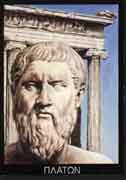.
 |
| Part of the series on: The Dialogues of Plato |
| Early dialogues: |
| Apology – Charmides – Crito |
| Euthyphro – First Alcibiades |
| Hippias Major – Hippias Minor |
| Ion – Laches – Lysis |
| Transitional & middle dialogues: |
| Cratylus – Euthydemus – Gorgias |
| Menexenus – Meno – Phaedo |
| Protagoras – Symposium |
| Later middle dialogues: |
| The Republic – Phaedrus |
| Parmenides – Theaetetus |
| Late dialogues: |
| Timaeus – Critias |
| The Sophist – The Statesman |
| Philebus – Laws |
| Of doubtful authenticity: |
| Clitophon – Epinomis |
| Epistles – Hipparchus |
| Minos – Rival Lovers |
| Second Alcibiades – Theages |
The Epinomis (Greek: Ἐπινομίς) is a dialogue in the style of Plato and traditionally included among Plato's works. Today it is widely considered spurious because of its contents and because already some ancient sources attributed it to Philip of Opus.
Title
The title Epinomis designates the work as an appendix to Plato's Laws (whose title in Greek is Nomoi). Our sources also make reference to it as the thirteenth book of the Laws (though this presupposes the division of that dialogue into twelve books, which "is probably not earlier than the Hellenistic age"[1]), as well as under the titles Nocturnal Council (because it deals with the higher education of that Council, beyond what is described in Laws, in mathematics-based astronomy) and Philosopher (probably because the Nocturnal Council's members are "the counterpart of the guardians in the Republic who are said to be the true philosophers"[2]).
Dramatis personae
The persons involved in the dialogue are the same as in Laws: Clinias of Crete, Megillus of Sparta, and an Athenian stranger.
Question of authenticity
The Epinomis forms part of the traditional canon of Plato's works (for example, it is included in the ninth and last of the Thrasyllan tetralogies). Already in antiquity, however, Diogenes Laertius and the sources used by the Suda attributed the work to Philip of Opus.
The authenticity of Epinomis has also been questioned on the grounds of its philosophical content. Leonardo Tarán, while finding parallels for many of the allegedly un-Platonic elements of the dialogue's style, declared it spurious based on (in the words of a sympathetic reviewer) "the much firmer ground of the misunderstanding or contradiction of Platonic doctrines, such as the placing of astronomy above dialectic as the supreme object of study, the rejection of the Ideas, the introduction of a fifth element, aether, between fire and air, and the elaborate theory of daemons inhabiting the three middle elements."[3] Werner Jaeger detected the influence of Aristotle's On Philosophy (a lost work Jaeger believed to have been published shortly before Epinomis in 348/347 BC) on much of the Epinomis, including the idea of the "fifth body."[4]
Gerard Ledger's stylometric analysis of Plato's works supports the authenticity of Epinomis, finding statistical similarities between this dialogue and Laws, Philebus, Sophist, and Timaeus (as well as the Seventh Letter).[5] Holger Thesleff, who suspected that Plato collaborated with younger associates in writing many of the works attributed to him, considered the closely related style of Laws and Epinomis to be a "secretary's style."[6]
Notes
- ^ Leonardo Tarán, "Proclus on the Old Academy," in Collected Papers 1962-1999 (Leiden: Brill, 2001), p. 602.
- ^ Leonardo Tarán, Academica: Plato, Philip of Opus, and the pseudo-Platonic Epinomis (Philadelphia: American Philosophical Society, 1975), p. 23 n. 88 and p. 132 n. 553.
- ^ John Dillon, review of L. Tarán, Academica: Plato, Philip of Opus and the Pseudo-Platonic Epinomis (Philadelphia: American Philosophical Society, 1975), in American Journal of Philology 101 (1980), pp. 486-488.
- ^ W. Jaeger, Aristotle: Fundamentals of the History of His Development, 2nd ed. (translated with the author's corrections and additions by R. Robinson), Oxford Univ. Press, 1948, p. 144 n. 2.
- ^ Charles M. Young, "Plato and Computer Dating," Oxford Studies in Ancient Philosophy 12 (1994), pp. 227-50, repr. Nicholas D. Smith (ed.), Plato: Critical Assessments 1 (London: Routledge, 1998), p. 35.
- ^ H. Thesleff, "Platonic Chronology," Phronesis 34 (1989), pp. 1-26, repr. in N.D. Smith (ed.), Plato: Critical Assessments, vol. 1 (London: Routledge, 1998), p. 60.
Links
- Epinomis in English
- Epinomis in Greek
| Ancient Greece
Science, Technology , Medicine , Warfare, , Biographies , Life , Cities/Places/Maps , Arts , Literature , Philosophy ,Olympics, Mythology , History , Images Medieval Greece / Byzantine Empire Science, Technology, Arts, , Warfare , Literature, Biographies, Icons, History Modern Greece Cities, Islands, Regions, Fauna/Flora ,Biographies , History , Warfare, Science/Technology, Literature, Music , Arts , Film/Actors , Sport , Fashion --- |
From Wikipedia, All text is available under the terms of the GNU Free Documentation License

